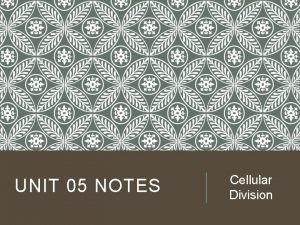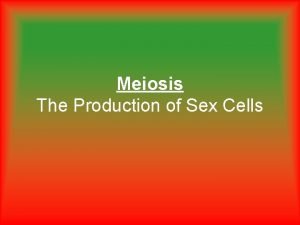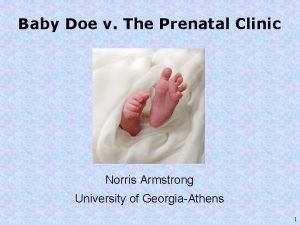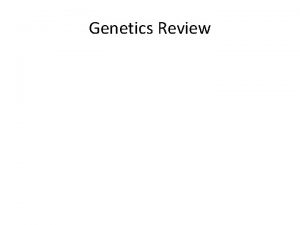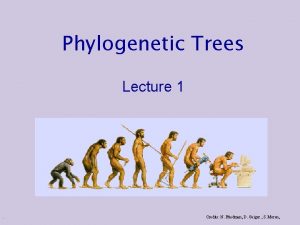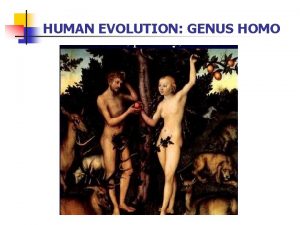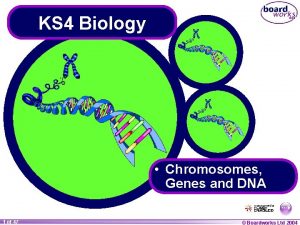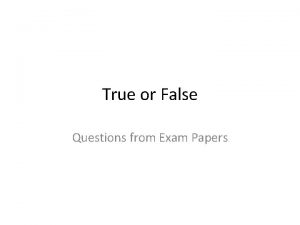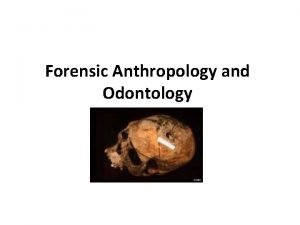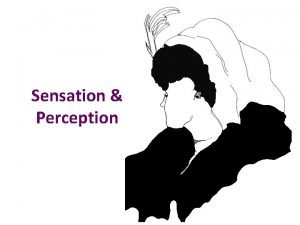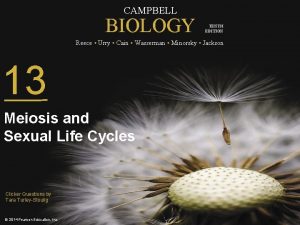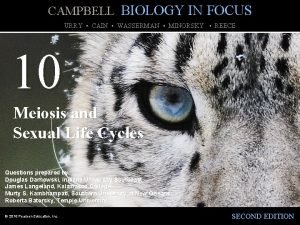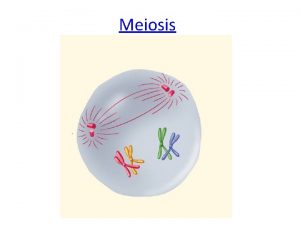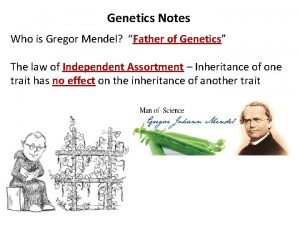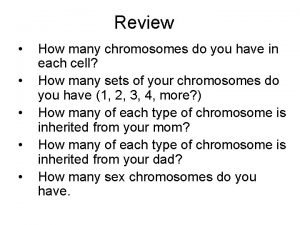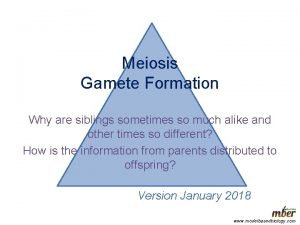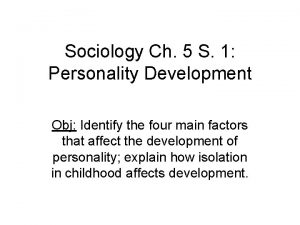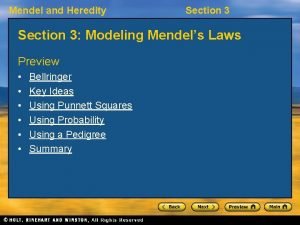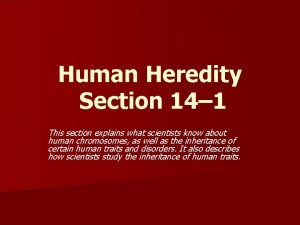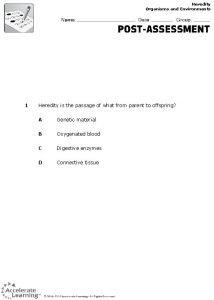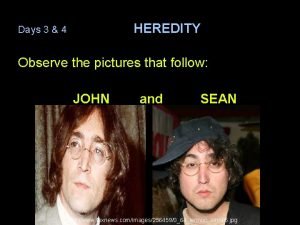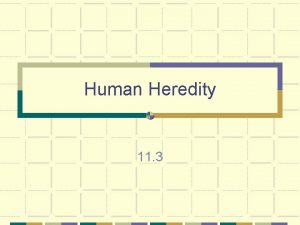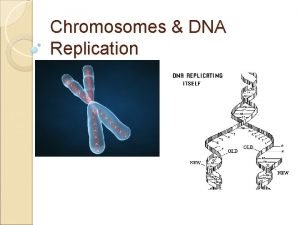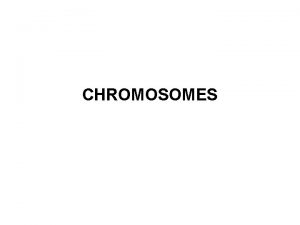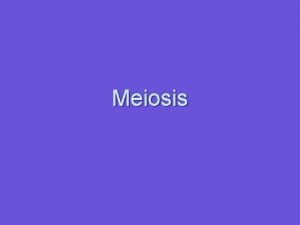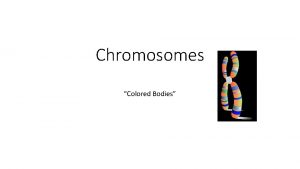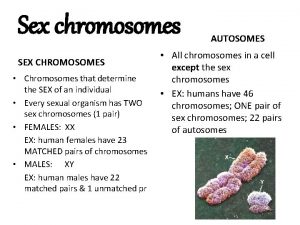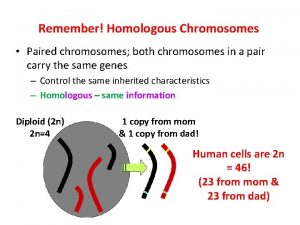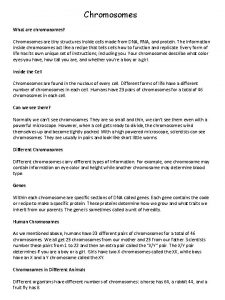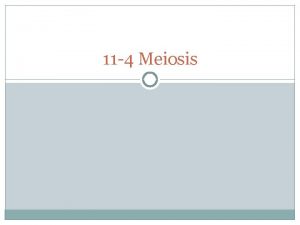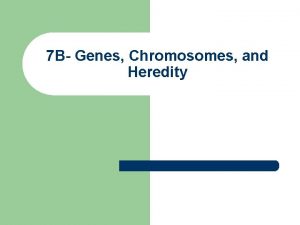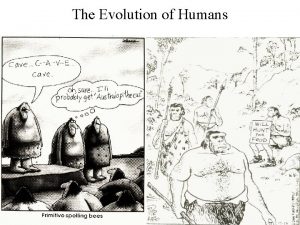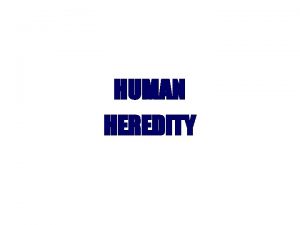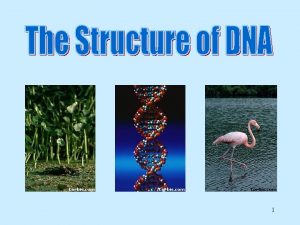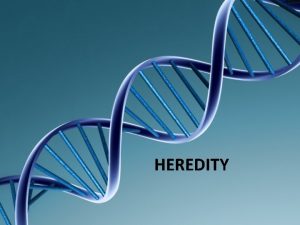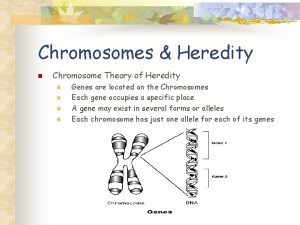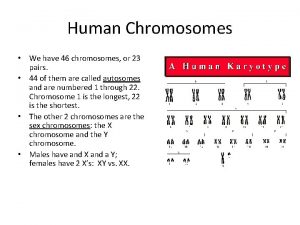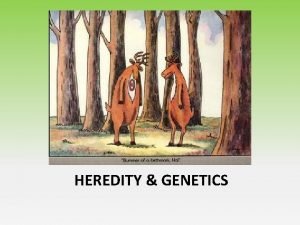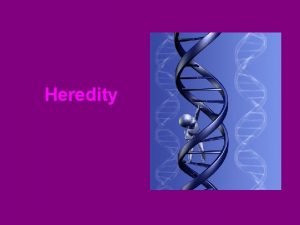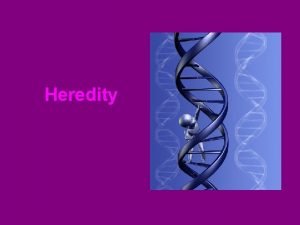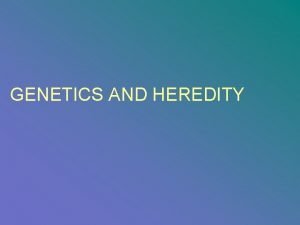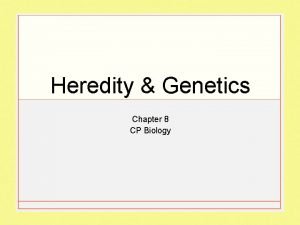HEREDITY EVOLUTION HEREDITY Humans have 46 chromosomes made


























- Slides: 26

HEREDITY & EVOLUTION

HEREDITY • Humans have 46 chromosomes, made up of 23 pairs. • A mother passes 23 chromosomes to her child through her egg and a father passes 23 chromosomes through his sperm.

• Each chromosome consists of a very long thin strand of DNA chains twisted into the shape of a double helix and are located in the nucleus (the ‘control centre’) of our body cells. • The chromosomes are long strands of genes. • Since the chromosomes come in pairs, the genes also come in pairs.



Human Karyotype

A homologous pair of chromosomes A pair of alleles (a certain form of gene at a locus)

Gene- The Unit of Heredity • A gene is a segment of DNA on a chromosome which governs the synthesis of one protein that controls a specific trait of an organism. • The gene that decides the appearance of an organism even in the presence of an alternative gene is called as dominant gene.

• The gene which can decide the appearance of an organism only in the presence of another identical gene is called a recessive gene. • The characteristic which is visible in an organism is called its phenotype. • The genetic makeup of an organism is called its genotype.

MONOHYBRID CROSS

DIHYBRID CROSS


WHAT IS EVOLUTION? In the broadest sense, evolution is merely a change. It is important to note that biological evolution refers to populations and not to individuals and that the changes must be passed on to the next generation. Evolution can be precisely defined as any change in the frequency of alleles within a gene pool from one generation to the next.

Charles Robert Darwin (1809 -1882) Journey of the Beagle

HOW DO WE KNOW THAT EVOLUTION HAS OCCURRED? The evidence for evolution has primarily come from five sources: The fossil records Comparative anatomy Comparative embryology Comparative physiology and biochemistry The geographic distribution of related species

EVIDENCE FROM FOSSIL RECORD It is the most direct evidence of macroevolution. Fossils are created when organisms become buried in sediment, the calcium in bone and other hard tissue is mineralized, and the sediment is eventually converted to rock. By dating the rocks in which fossils occur, scientists can get a very accurate idea of the fossils’ age. There are different ways to calculate the age of fossils.

FOSSIL DATING The best-known absolute dating technique is carbon -14 dating. All organisms have a fixed ratio of C-12 and C-14. After death C-14 decays and its amount decreases. The half-life of carbon 14 is only 5730 years, so the method cannot be used for materials older than about 70, 000 years.

FOSSILS – RELICS FROM THE PAST AMMONITE CYCADOPHYTE TRILOBITE DRAGON-FLY DINOSAUR

EVIDENCE FROM ANATOMY Ulna Radius Humerus «In all tetrapods, the forelimbs have the same basic pattern – humerus, radius, ulna, metacarpals and phalanges. «However these animals perform different functions with their forelimbs due to adaptations to different needs. «Homology leads to divergent evolution indicating common ancestry.

HOMOLOGOUS ORGANS Thorn Tendril BOUGAINVILLEA CUCURBITA Thorns of Bougainvillea and tendrils of Cucurbita are modified axillary buds but have different functions.

EVIDENCE FROM ANATOMY Analogous organs are similar in function but are anatomically different and unrelated e. g. Wings of birds, insects. Convergent evolution - Similar adaptation by unrelated groups through modification or evolution of different parts for e. g. eye of an octopus and eye of mammal are analogous as these differ in retinal position. Analogy leads to convergent evolution due similar selection pressures acting on unrelated organisms.

ANALOGOUS ORGANS Same selection pressures Different skeletal structures Wing of an insect, pterodactyl, bird and bat

Embryos of all vertebrates have similar patterns showing common ancestry. EMBRYOLOGICAL EVIDENCES

LAMARCKISM Jean Baptiste Lamarck, a French naturalist had given an evolutionary theory much before Darwin. According to Lamarckism evolution of life forms occurred by use and disuse of organs. He gave examples of giraffes whose necks became longer by stretching in an attempt to forage leaves on tall trees during a period of drought. This acquired trait was inherited by future generations.

DARWIN’S THEORY Darwin’s theory can be summarized as: Reproductive ability of population to increase in number Struggle for existence Natural selection (survival of the fittest) Limited environmental resources Hereditary Variations Change in the environment EVOLUTION

Prosimians New World Monkeys Old World Monkeys Gibbon Orangutan Gorilla Chimpanzee Modern Man 10 20 Australopithecus 30 40 Dryopithecus (Proconsul) 50 60 m. y. a PRIMATE EVOLUTION
 23 chromosome pairs
23 chromosome pairs Number of chromosomes in meiosis
Number of chromosomes in meiosis How many chromosomes do humans have
How many chromosomes do humans have How many pairs of chromosomes
How many pairs of chromosomes Evolution
Evolution Primate evolutionary tree
Primate evolutionary tree Evolution of humans timeline
Evolution of humans timeline What are chromosomes made of
What are chromosomes made of Chromosomes are made up of
Chromosomes are made up of Differences between the male and female skeleton
Differences between the male and female skeleton Absolute threshold psychology definition
Absolute threshold psychology definition Privet shrubs and humans each have a diploid number of 46
Privet shrubs and humans each have a diploid number of 46 Privet shrubs and humans each have a diploid number of 46
Privet shrubs and humans each have a diploid number of 46 Sternal notch location
Sternal notch location Meiosis
Meiosis What happens if you have 45 chromosomes
What happens if you have 45 chromosomes Section 11-4 meiosis
Section 11-4 meiosis How many chromosome does a sperm cell have
How many chromosome does a sperm cell have How many chromosomes do we have
How many chromosomes do we have 6 flat faces 12 edges 8 vertices
6 flat faces 12 edges 8 vertices Brainpop heredity worksheet answer key
Brainpop heredity worksheet answer key Heredity characteristics include body build
Heredity characteristics include body build Mendelian genetics concept map
Mendelian genetics concept map Section 3 mendel and heredity
Section 3 mendel and heredity 14-1 human heredity
14-1 human heredity Heredity defines the passage of genetic material from –
Heredity defines the passage of genetic material from – Pictures of heredity
Pictures of heredity
